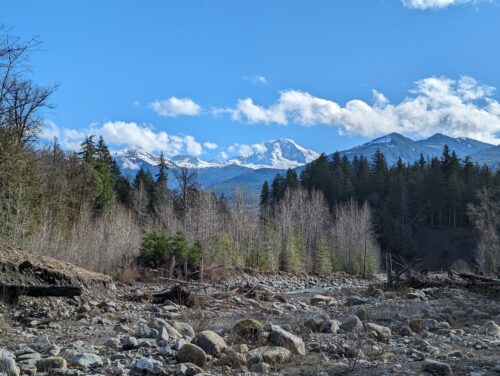
A fine day at the north fork of the Nooksak River, near Glacier, WA. HW found a bunch of fossils here during our recent exploration of the area. Mount Baker looms in the distance. It’s one of the youngest volcanic peaks in the Cascade range. Unambiguous evidence dates the last eruption here at about 6,600 years ago. The entire watershed is a major source of fresh water for the state, and for the generation of hydroelectric power which accounts for about 65% of the state’s electrical output. The more famous Mt. St. Helens on the Pacific Ring of Fire is the only volcano in the Cascade Range with a more active thermal crater than Mt. Baker. When I was a student in the Geoscience program at Wisconsin (early ’80s), I traveled out West for a summer field course and was fortunate to visit Mt. St. Helens a year or more after it erupted in May, 1980. The explosion removed most of the north face of the mountain. I’d never before observed that scale of destruction by a natural force, truly jaw dropping. When we were in Portland recently with friends, the four of us drove north to spend a few hours at the St. Helens visitor center. Watching the time-lapse video of the eruption brought back a lot of memories of my first trip there. Measured in geologic time, though, it was like a blink-of-an-eye ago.
Will Mt. Baker erupt in the near future? Probably. In 1860, travelers aboard a steamboat headed to Victoria, BC reported seeing plumes of smoke rising from one of the craters on Mt. Baker, and there was a scare in 1975 and another in 2007. But none of those rumblings led to a full on eruption like was seen at Mt. St. Helens. But it’s probably just a matter of time. I’ll be thankful not to be standing this close the day it happens.
